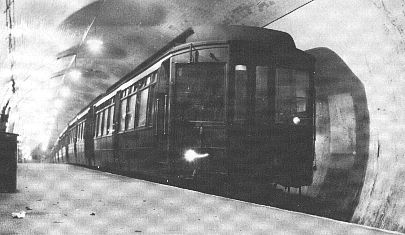
Suburban Electric Railway Association
Located at the COVENTRY ELECTRIC RAILWAY CENTRE, Rowley Road, Baginton, Warwickshire
Established
1996
The History Zone
Electrifying London
The East London Line

The East London Railway opened their initial line from New Cross Gate station to Wapping on December 7th 1869, The steam hauled service was operated by the London, Brighton & South Coast Railway. The line crossed under the Thames through a tunnel that had bee completed in 1843 by the civil engineer Marc Brunel and had been used until acquired by the railway company as a pedestrian subway. The construction of this tunnel had been a mamouth task undertaken over a number of years and had been the first use of 'shield excavation' a method that was to pave the way for the construction of many of London's tube lines.
The line was extended to Shoreditch on April 10th 1876 where a connection was made with the Great Eastern Railway that allowed the LB&SC trains to run into Liverpool Street and on the 1st of April 1880 a spur to New Cross (South Eastern Railway) was opened. The final addition to the formation was a spur linking Whitechapel (District Railway) to the ELR which opened on March 3rd 1884.
The East London Railway Company never owned locomotives or rolling stock as all the passenger services over the route in steam days were provided by no fewer than four different companies.: The LB&SCR, The South Eastern Railway, The Metropolitan Railway and The District Railway. The later two ceased running over the route in 1906 and 1905 respectively due to the ELR not being electrified when their relevant electric services took over from steam. Electrification of the ELR was given consideration and undertaken in 1912.
The ELR took their power for the electric traction supply from the UERL power station at Lotts Road with the Metropolitan Railway providing the train service, which commenced on March the 31st 1913. Over the following years this is still the pattern with the rolling stock provided by the Metropolitan Line fleet.
The east London Railway Company was absorbed by the Southern Railway in the grouping of 1923 and with nationalisation of 1948 passed to the control of the London Passenger Transport Board.
The Great Northern And City Railway

This line was opened in February 1904 over a distance of three and a half miles from Findsbury Park (under the Great Northern Railway station) to Moorgate in the city of London. It was built entirely in tube tunnel but these tunnels had a diameter of sixteen feet and thus permitted the use of 'surface' gauge rolling stock. The line used multiple unit stock from the outset with the cars being built in two batches by Brush of Loughborough and The Electric Tramway & Carriage Works of Preston (pictured above). The second batch of cars were notable for being the first all steel EMU cars built in Britain. The layout of all vehicles followed standard practice at the time with open saloon interior and gate end platforms. Both the positive and negative rails were placed outside the track gauge (as with the Earls Court experimental train) and this system was used until the original stock was withdrawn in 1939.
The GN&C came under the control of the Metropolitan Railway in 1913 and some of their rolling stock was used during the early 1930s alongside original stock. Under the 1935 new works programme the GN&C came under the control of the Northern Line and the result of this was the replacement of the original units with standard stock tube trains. The service was cut back to run only as far as Drayton Park from 1964 as Findsbury Park was being rebuilt in connection with the construction of the Victoria Line. This remained the case until 1976 when the line came under the control of British Railways Eastern Region and after the rebuilding of a connection from Drayton Park to the surface station at Findsbury Park a service was run from Welwyn and Hertford over the former GN&C into Moorgate by BR dual voltage class 313 EMUs running on the third rail system over the tunnel section.
